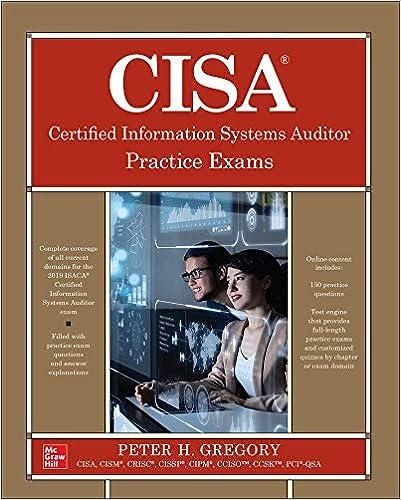Question
1. In preparing a statement of cash flows, a conversion of bonds into common stock will be reported in a. the financing section. b. the
1. In preparing a statement of cash flows, a conversion of bonds into common stock will be reported in
a. the financing section.
b. the "extraordinary" section.
c. a separate schedule or note to the financial statements.
d. the stockholders' equity section.
2. Which one of the following affects cash during a period?
a. Recording depreciation expense
b. Declaration of a cash dividend
c. Write-off of an uncollectible account receivable
d. Payment of an accounts payable
3. Horizontal analysis evaluates a series of financial statement data over a period of time
a. that has been arranged from the highest number to the lowest number.
b. that has been arranged from the lowest number to the highest number.
c. to determine which items are in error.
d. to determine the amount and/or percentage increase or decrease that has taken place.
4. Which one of the following is not a characteristic generally evaluated in analyzing financial statements?
a. Liquidity
b. Profitability
c. Marketability
d. Solvency
5. A major disadvantage resulting from the use of bonds is that
a. earnings per share may be lowered.
b. interest must be paid on a periodic basis.
c. bondholders have voting rights.
d. taxes may increase.
6. When bonds are converted into common stock,
a. the market price of the stock on the date of conversion is credited to the Common Stock account.
b. the market price of the stock and the bonds is ignored when recording the conversion.
c. the market price of the bonds on the date of conversion is credited to the Common Stock account.
d. gains or losses on the conversion are recognized.
7. If a stockholder receives a dividend that reduces retained earnings by the fair market value of the stock, the stockholder has received a
a. large stock dividend.
b. cash dividend.
c. contingent dividend.
d. small stock dividend
8. If bonds are originally sold at a discount using the straight-line amortization method:
a. Interest expense in the earlier years of the bonds life will be less than the interest to be paid.
b. Interest expense in the earlier years of the bonds life will be the same as interest to be paid.
c. Unamortized discount is subtracted from the face value of the bond to determine its carrying value.
d. Unamortized discount is added to the face value of the bond to determine its carrying value.
9. Corporations invest in other companies for all of the following reasons except to
a. house excess cash until needed.
b. generate earnings.
c. meet strategic goals.
d. increase trading of the other companies stock.
10. Under the equity method, the Stock Investments account is increased when the
a. investee company reports net income.
b. investee company pays a dividend.
c. investee company reports a loss.
d. stock investment is sold at a gain.
11. Securities bought and held primarily for sale in the near term to generate income on short-term price differences are
a. trading securities.
b. available-for-sale securities.
c. never-sell securities.
d. held-to-maturity securities.
12. All of the following statements about short-term investments are true except:
a. Short-term investments are also called marketable securities
b. Trading securities are always classified as short-term investments.
c Short-term assets must be readily marketable.
d. Short-term investments are listed below accounts receivable in the current asset section of the balance sheet.
13. If bonds with a face value of $150,000 are converted into common stock when the carrying value of the bonds is $135,000, the entry to record the conversion will include a debit to
a. Bonds Payable for $150,000.
b. Bonds Payable for $135,000.
c. Discount on Bonds Payable for $15,000.
d. Bonds Payable equal to the market price of the bonds on the date of conversion
14. An unrealized loss on available-for-sale securities is
a. reported under Other Expenses and Losses in the income statement.
b. closed-out at the end of the accounting period.
c. reported as a separate component of stockholders' equity.
d. deducted from the cost of the investment
15. Which of the following is not a true statement regarding short-term debt investments?
a. The securities usually pay interest.
b. Investments are frequently government or corporate bonds.
c. This type of investment must be currently traded in the securities market.
d. Debt investments are recorded at the price paid less brokerage fees.
Step by Step Solution
There are 3 Steps involved in it
Step: 1

Get Instant Access to Expert-Tailored Solutions
See step-by-step solutions with expert insights and AI powered tools for academic success
Step: 2

Step: 3

Ace Your Homework with AI
Get the answers you need in no time with our AI-driven, step-by-step assistance
Get Started


